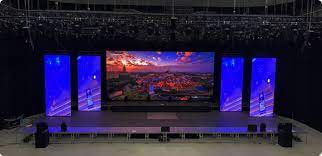Introduction
In this digital age, LED screens have become ubiquitous, gracing various devices and spaces. From smartphones and TVs to billboards and stadiums, LED screens are the display technology of choice. In this article, we will delve into the world of LED screens, exploring their history, technology, applications, advantages, and future prospects.
1. What is an LED Screen?
An LED (Light Emitting Diode) screen is a flat-panel display that utilizes light-emitting diodes to produce images. These screens are commonly found in electronic devices and various public settings, delivering vibrant visuals and exceptional clarity.
2. The Evolution of LED Screens
2.1 Early Beginnings of LEDs
The development of LEDs can be traced back to the early 1960s when Nick Holonyak Jr. invented the first visible-spectrum LED. However, these early LEDs were not suitable for display purposes due to their limited color options and low intensity.
2.2 Introduction of RGB LEDs
In the 1970s, the introduction of RGB (Red, Green, Blue) LEDs paved the way for color displays. This breakthrough allowed for a wider gamut of colors and improved image quality.
2.3 Advancements in Pixel Density
Over the years, LED screens witnessed significant advancements in pixel density, enabling higher-resolution displays that could render intricate details with precision.
2.4 The Rise of OLED Displays
While OLED (Organic Light Emitting Diode) displays gained popularity due to their self-emissive nature, traditional LED screens continued to dominate the market due to their cost-effectiveness and reliability.
3. How Do LED Screens Work?
3.1 The Role of LEDs in Display
LED screens are made up of an array of tiny LEDs, acting as individual pixels. These pixels emit light when an electric current passes through them, illuminating the corresponding section of the screen.
3.2 Controlling Brightness and Color
To display images and videos, LED screens modulate the brightness and color of each LED independently, resulting in a dynamic visual experience.
3.3 Backlighting vs. Self-Emissive Displays
LED screens can be classified into two types: backlighting and self-emissive displays. Backlit LED screens use LEDs to illuminate liquid crystals, while self-emissive displays, such as OLED, eliminate the need for backlighting as each pixel emits its light.

4. Applications of LED Screens
4.1 Consumer Electronics
LED screens are extensively used in consumer electronics, including smartphones, tablets, laptops, and televisions, providing users with high-definition displays for an immersive viewing experience.
4.2 Digital Signage
The versatility and brightness of LED screens make them a preferred choice for outdoor and indoor digital signage, advertising, and information display systems.
4.3 Sports Stadiums and Arenas
LED screens in sports venues offer spectators a larger-than-life experience, displaying real-time action and instant replays in stunning clarity.
4.4 Automotive Displays
Modern vehicles are equipped with LED screens for infotainment systems, GPS navigation, and driver assistance displays.
4.5 Architectural Lighting
LED screens are incorporated into architectural designs, transforming buildings into dynamic canvases of art with vibrant lighting displays.
5. Advantages of LED Screens
5.1 Energy Efficiency
LED screens consume less power than traditional displays, making them environmentally friendly and cost-effective.
5.2 Enhanced Brightness and Color
With their high brightness levels and excellent color reproduction, LED screens deliver captivating visuals even in well-lit environments.
5.3 Durability and Longevity
LEDs have a longer lifespan compared to other display technologies, reducing maintenance costs and ensuring prolonged usability.
5.4 Flexibility and Scalability
LED screens can be custom-made in various shapes and sizes, making them adaptable to unique requirements.
6. Future Prospects
The future of LED screens looks promising, with ongoing research and development aiming to further enhance image quality, reduce thickness, and improve flexibility. As technology advances, LED screens may become more ubiquitous in our daily lives.
Conclusion
In conclusion, LED screens have revolutionized the way we consume visual content, from the smallest handheld devices to large-scale displays. Their impressive color reproduction, energy efficiency, and durability have solidified their position as a preferred display technology. As we move towards a more technologically advanced future, LED screens will undoubtedly continue to play a vital role in shaping our visual experiences.
FAQs (Frequently Asked Questions)
Q1: Are LED screens better than LCD screens? A1: LED screens generally offer superior brightness, color vibrancy, and energy efficiency compared to traditional LCD screens.
Q2: Can LED screens be used outdoors? A2: Yes, LED screens are well-suited for outdoor use due to their high brightness and weather-resistant properties.
Q3: Do LED screens suffer from image burn-in? A3: Unlike some display technologies, LED screens are not prone to image burn-in, ensuring long-term image quality.
Q4: Are OLED displays better than LED screens? A4: OLED displays have certain advantages, such as deeper blacks and thinner form factors, but LED screens remain popular due to their cost-effectiveness and versatility.
Q5: Can LED screens be curved? A5: Yes, LED screens can be manufactured in curved shapes, allowing for creative and immersive display installations.


No comments yet